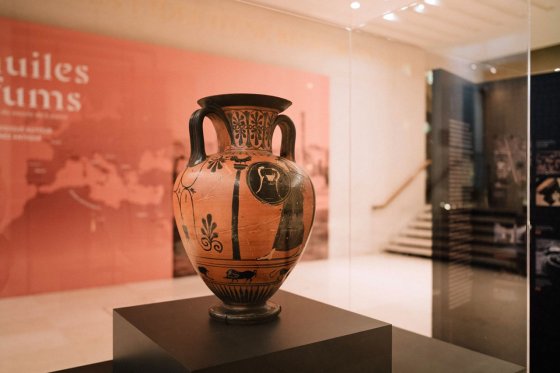Julien Auber de Lapierre, curator of the "Wines, Oils and Perfumes: An Archaeological Journey Around the Ancient Mediterranean" exhibition at the Collège de France until January 31, 2025, talks about the exceptional objects on display.

What does the exhibition "Wines, oils and perfumes: an archaeological journey around the ancient Mediterranean" offer?
The exhibition retraces a large part of the career of Professor Jean-Pierre Brun, holder of the Techniques and Economies in the Ancient Mediterranean chair, but above all a field archaeologist. His research has taken him to numerous archaeological sites around the Mediterranean, from southern France to Naples, via Pompeii and Cumae, as well as the Iberian Peninsula, Greece, Egypt and the Levant.
This exhibition highlights Jean-Pierre Brun's groundbreaking contributions to archaeology, particularly in understanding the production and consumption of wine, oils and perfumes in antiquity. We've organized the exhibition around four main geographical areas - Gaul, Pompeii, Delos in Greece, and Egypt - focusing on the 1st century AD.
What will visitors to discover?
This exhibition is a first for the Collège de France, as it is organized on two sites: the Institute of Civilizations and the historic site of Place Marcelin-Berthelot. At the Institute of Civilizations, we have brought together some thirty objects, mainly on loan from the Musée des Beaux-Arts de Lyon, the Centre archéologique du Var, the Service archéologique de la Ville de Lyon and the Musée international de la Parfumerie de Grasse. Among the exhibits are amphorae, olive stones, grape seeds and cork stoppers, all bearing witness to the production of wine and oil in the South of France. Visitors will also be able to discover a model of the seasidevilla of Pardigon, a wine-producing site excavated by Pr Jean-Pierre Brun, as well as a model of a doliaboat, the large jars used to store wine during transport, on loan from the Guigal family. This illustrates the large-scale trade in wine around the Mediterranean Sea, a central aspect of Pr Jean-Pierre Brun's research. The Marcelin-Berthelot site hosts exceptional loans from the Musée du Louvre, including ceramics, amphorae and bronze and glass pieces, evoking the consumption of wine by Greek and Roman elites.
The exhibition also features sensory experiences, notably around ancient perfumes?
We have set up what we call a "scent experience", based on the reconstitution of an ancient perfume. Pr Jean-Pierre Brun worked for over ten years on perfume vases that still contained organic residues. Thanks to chemical analyses and ancient recipes, such as those of Dioscorides, a Greek pharmacologist, we were able to recreate these perfumes. For the exhibition, Prof. XavierFernandez of the Université Côte d'Azur has recreated Rhodinon, a perfume made from green olive oil and Damask rose petals. This perfume was widely used in the ancient world, both for aesthetic and medical purposes. Visitors can smell it via an interactive device installed at the Institute of Civilizations.
A program of conferences is also planned to accompany the exhibition?
A number of conferences have been organized to enrich the exhibition visit, and to provide a rhythm to the event and to keep visitors coming back for more. These are not just about the exhibition itself, but also about the people who worked on it, to give you a complete overview of the work carried out by Prof. Jean-Pierre Brun during his career, through different themes such as Roman forts in the desert, the visualization of archaeology, or the links with current wine production.








